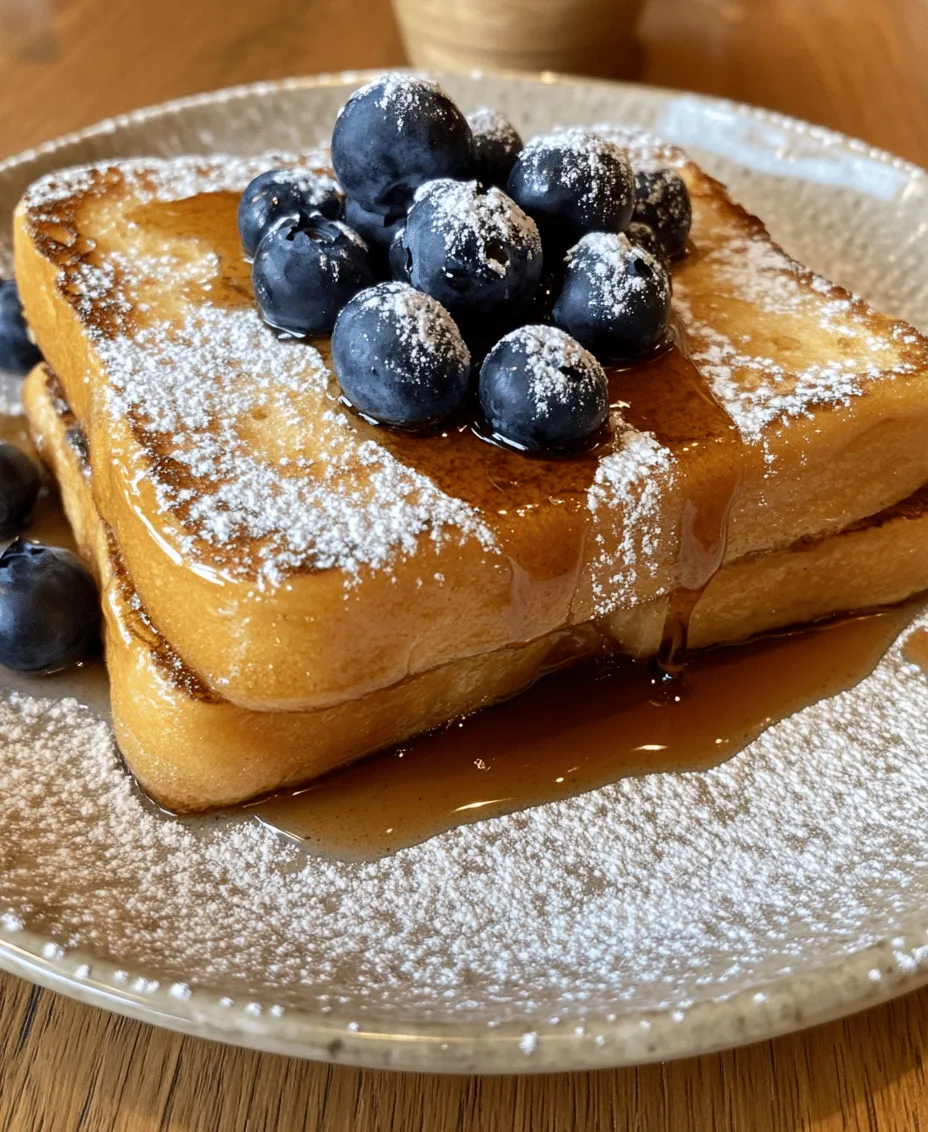Introduction
French toast is a cherished breakfast staple that perfectly balances simplicity and indulgence. Known for its warm, comforting flavors, French toast transforms humble ingredients into a delightful dish that can be enjoyed any day of the week. This quick and easy French toast recipe is designed for those busy mornings when time is of the essence, yet a delicious meal is a must. Whether you are rushing off to work, getting the kids ready for school, or simply want to savor a delightful breakfast without the fuss, this recipe ensures you can whip up gourmet-level French toast in no time.
What makes this recipe particularly appealing is its versatility. The base recipe is straightforward, allowing for a myriad of toppings and adaptations to cater to individual preferences. From fresh fruits and whipped cream to maple syrup and nut butters, the possibilities are endless. Each variation brings a unique twist to the dish, making it a favorite among families and brunch enthusiasts alike.
Understanding French Toast
The classic French toast, known as “pain perdu” in France, has a rich history that spans cultures and centuries. Its origins can be traced back to ancient Rome, where a similar dish was made by soaking bread in a mixture of milk and egg before frying it. This method was originally developed as a way to use stale bread, ensuring that nothing went to waste. Over time, as the dish spread across Europe and beyond, different cultures began to put their own spin on it.
In France, the dish is often enjoyed as a sweet treat, dusted with powdered sugar and served with syrup or fruit. In contrast, many Latin American countries have adapted French toast into their own variations, using local ingredients and flavors. For instance, in Mexico, “tostadas de leche” are made using sweet bread and served with a drizzle of cajeta, a goat milk caramel. This cultural significance highlights French toast’s ability to transcend borders, evolving into a beloved breakfast item worldwide.
Key Ingredients for the Perfect French Toast
To achieve the ideal French toast, understanding the key ingredients and their roles is essential. Here’s a breakdown of the components that will elevate your dish:
Thick Bread Choices
The foundation of any great French toast begins with the bread. While any type of bread can technically be used, thicker slices yield the best results. Bread varieties such as brioche or challah are particularly favored due to their rich, buttery texture. These types of bread absorb the custard mixture beautifully, resulting in a soft, pillowy interior that contrasts perfectly with a golden, crispy exterior. The richness of brioche and challah not only enhances the flavor but also adds an element of indulgence to your breakfast.
Eggs and Dairy
Eggs are the star ingredient in French toast, providing the custard-like base that makes the dish so delightful. When whisked together with milk or a non-dairy alternative, eggs create a creamy mixture that clings to the bread, resulting in a luscious texture. Whole milk is typically preferred for its creaminess; however, alternatives such as almond milk or oat milk can also be used without sacrificing flavor. The choice of dairy can subtly influence the overall taste of the French toast, so select one that aligns with your personal preferences or dietary needs.
Flavor Enhancers
To take your French toast to the next level, consider adding flavor enhancers like vanilla extract, cinnamon, and a pinch of salt. A splash of vanilla extract introduces a warm, aromatic element that complements the sweetness of the dish. Cinnamon adds a comforting spice, infusing each bite with warmth and depth. Meanwhile, a small pinch of salt balances the flavors, ensuring that the sweetness does not overwhelm the palate. These simple additions transform a basic recipe into a gourmet experience.
Step-by-Step Instructions for Quick and Easy French Toast
Creating the perfect French toast is a straightforward process, and with a few simple steps, you’ll have a delicious breakfast ready in no time. Let’s walk through the preparation of the egg mixture, an essential step for achieving that custard-like texture.
Preparation of the Egg Mixture
1. Gather Your Ingredients: Start by gathering all the necessary ingredients: your choice of thick bread (like brioche or challah), eggs, milk, vanilla extract, cinnamon, and salt.
2. Crack the Eggs: In a medium-sized mixing bowl, crack the desired number of eggs. For a serving of two to four people, three eggs are typically sufficient.
3. Add Milk: Pour in about one cup of milk. If you’re opting for a non-dairy alternative, measure the same amount.
4. Whisk Together: Using a whisk or fork, beat the eggs and milk together until the mixture is well combined and slightly frothy. This ensures that the eggs are fully incorporated into the milk, creating a uniform custard that will coat the bread evenly.
5. Incorporate Flavor Enhancers: Add a teaspoon of vanilla extract and a dash of cinnamon to the egg mixture. You can also include a pinch of salt at this stage. Continue whisking until everything is combined, and the mixture is smooth.
This egg mixture forms the basis of your French toast, providing both flavor and texture. The next steps will involve soaking the bread in this custard before cooking it to perfection. Stay tuned for the detailed cooking instructions that will guide you through the rest of this quick and easy French toast recipe!

Cooking Technique
To achieve the perfect golden-brown crust on your French toast, it’s essential to master the cooking technique. Start by preheating your skillet or griddle over medium heat. This temperature is crucial; if it’s too hot, the outside of the bread may burn before the inside cooks through. If it’s too low, you’ll miss out on that delightful crispy texture.
To test if your skillet is ready, sprinkle a few drops of water onto the surface. If they dance and evaporate almost immediately, you’re good to go. For best results, add a pat of butter or a splash of oil to the pan just before placing your soaked bread slices. The fat not only prevents sticking but also contributes to that coveted crispy exterior.
Cook each slice for about 2 to 4 minutes on each side, or until they reach a beautiful golden color. Keep an eye on them as they cook; every stove and skillet can behave a little differently, so adjustments may be necessary. Once both sides are perfectly browned, remove the French toast from the skillet and place them on a warm plate to maintain their temperature while you finish cooking the remaining slices.
Serving Suggestions
Once your French toast is cooked to perfection, it’s time to serve! Enjoy it warm, as it is when the flavors are at their best. A drizzle of pure maple syrup is a classic choice that enhances the sweetness of the dish. Pour it generously over the French toast to let it soak into those delicious crevices.
For an added touch, consider some optional toppings that can elevate your breakfast experience. Fresh berries, such as strawberries, blueberries, or raspberries, provide vibrant color and a burst of flavor. Sliced bananas can add a creamy texture, while a sprinkle of powdered sugar can give a delightful finish that looks as good as it tastes.
If you’re feeling indulgent, whipped cream can turn your French toast into a decadent treat, perfect for weekend brunches. For a gourmet twist, try drizzling flavored syrups, like caramel or hazelnut, or even spreading Nutella on top for a rich, chocolatey delight.
Creative Variations of French Toast
The beauty of French toast lies not only in its simplicity but also in its versatility. Feel free to experiment with different ingredients and toppings to create a breakfast that’s uniquely yours.
Fruit-Infused Options
Incorporating fruits into your French toast can add both flavor and nutrition. You can blend fruits like bananas or apples directly into the custard mixture for a fruity flavor throughout. For a fresher approach, consider topping your cooked French toast with a medley of seasonal fruits. Berries, in particular, pair exceptionally well and can provide a refreshing contrast to the sweet custard.
Decadent Toppings
Why stop at just maple syrup? Dive into a world of decadent toppings! Whipped cream is a fantastic option for those who enjoy a little indulgence. You can also experiment with flavored syrups like caramel, chocolate, or even fruit-infused options. If you’re a fan of Nutella, a spread of this chocolate-hazelnut goodness can take your French toast to new heights.
Consider garnishing with crushed nuts or a sprinkle of cinnamon for an added crunch or warmth. The combination of textures and flavors can create a breakfast masterpiece.
Savory Alternatives
For those who prefer a savory twist, French toast can be easily transformed into a delightful dish that strays from the traditional sweet route. By omitting sugar from your custard mixture and adding a pinch of salt, you can create a base that pairs well with cheese, herbs, or even sautéed vegetables.
Try incorporating ingredients like feta cheese, fresh herbs like chives or parsley, or even cooked spinach to bring a savory depth to your breakfast. This alternative can be served alongside a simple salad for a fulfilling brunch or light lunch option.
Nutritional Information
Understanding the nutritional content of your French toast can help you make informed choices, especially if you’re watching your diet. A standard slice of French toast made with whole milk and eggs typically contains around 150-200 calories, depending on the bread used. The protein content will also vary, usually providing about 6-8 grams per slice, primarily from the eggs and dairy.
In terms of carbohydrates, expect around 25-30 grams per slice, which comes primarily from the bread. Fats can range from 5 to 10 grams, largely impacted by the amount of butter or oil used during cooking.
It’s important to consider portion sizes and the toppings you choose, as these can significantly affect the overall nutritional profile. For instance, a generous drizzle of syrup can add additional calories and sugar. To keep your breakfast balanced, consider using fresh fruit as a topping instead of syrup, or opt for lighter toppings like Greek yogurt.
Conclusion
This quick and easy French toast recipe is the perfect go-to breakfast option for busy mornings. With minimal ingredients and straightforward steps, it allows anyone to whip up a delightful meal that brings joy to the breakfast table. Whether you stick to the classic version or get creative with variations and toppings, French toast can cater to all tastes and preferences.
Encourage yourself to embrace your culinary creativity. From fruity additions to savory alternatives, the possibilities are endless. So the next time you find yourself short on time yet craving a delicious breakfast, remember that with just a few pantry staples and a little imagination, you can create a meal that is both satisfying and memorable. Happy cooking!

